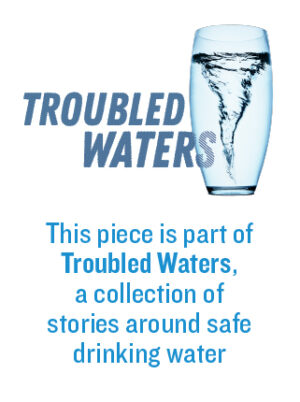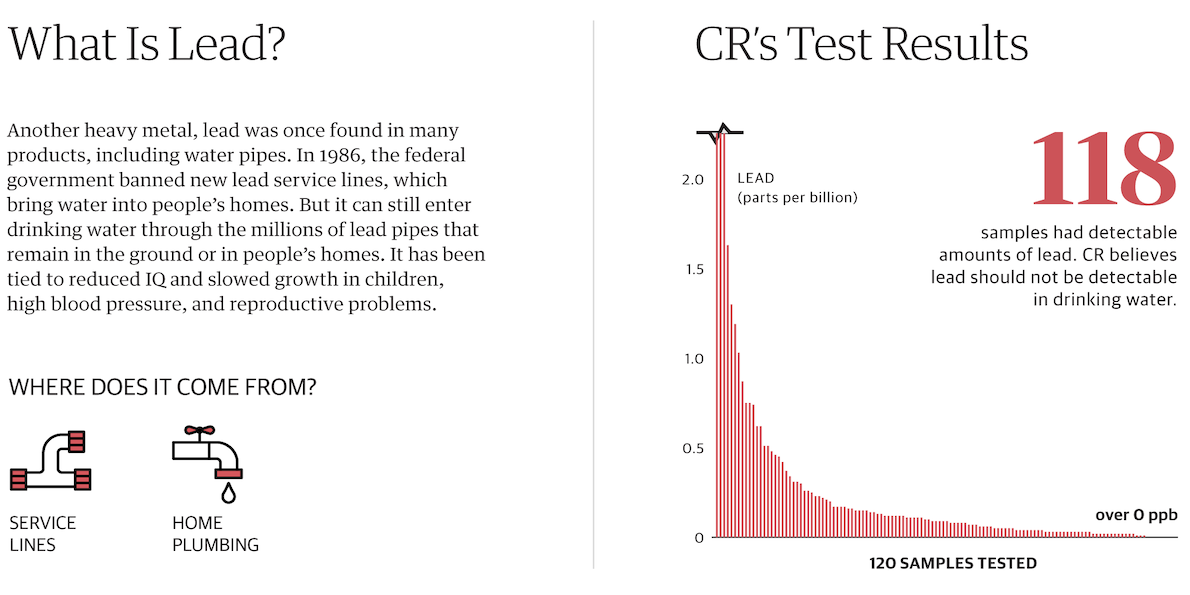July 15, 2021 —  Editor’s note: This story is part of a year-long investigation of drinking water contamination across the U.S. The series is supported by funding from the Park Foundation and Water Foundation. Read the launch story, “Thirsting for Solutions,” here. This story is co-published with The Guardian.
Editor’s note: This story is part of a year-long investigation of drinking water contamination across the U.S. The series is supported by funding from the Park Foundation and Water Foundation. Read the launch story, “Thirsting for Solutions,” here. This story is co-published with The Guardian.
In July 2018, tests showed that the drinking water supply serving Yvette Jordan’s home in Newark, New Jersey, contained nearly 45 parts per billion (ppb) of lead — three times the U.S. Environmental Protection Agency’s action level for the neurotoxic heavy metal. It was a similar story for many families across her city. A lead crisis had struck Newark, and it was drawing comparisons to the tainted water that devastated Flint, Michigan, a few years earlier.
Yet what subsequently played out in Newark — for the most part, anyway — should serve as a “national model,” says Jordan, who is a high school history teacher.
Across the U.S., between six and ten million old pipes made of lead still connect people’s homes with local water supplies. As these underground lines age and corrode, more and more people are being exposed to lead, including young children who are particularly vulnerable to the metal’s impacts. A report by the Natural Resources Defense Council (NRDC) estimates that between January 2015 and March 2018, at least 5.5 million Americans received water contaminated with levels of lead that exceed the Environmental Protection Agency (EPA) action level of 15 ppb. Other research finds that lower-income and minority communities are disproportionately affected.
In addition to lowering that action level — and making it more enforceable — public health experts urge the widespread replacement of all of these pipes. The Biden administration won praise when it unveiled a goal in March of replacing 100% of the nation’s lead service lines, and it insists this is still achievable as talks with Republicans continue on infrastructure legislation.
Newark has shown that doing so doesn’t have to be a pipe dream. Still, eliminating lead from U.S. drinking water will not be an easy task.
“We’ve known how to do this for decades. It’s not like treating PFAS or any of these multisyllabic chemicals,” says Daniel Van Abs, a water-use expert at Rutgers University in New Brunswick, New Jersey.
“We know what the issue is, we know what the health effects are, we know how to deal with it,” he adds. “It really comes down to political will.”
Since early 2019, residents of Newark have watched workers dig up and swap out thousands of lead lines that long linked their homes with the city’s water main. Jordan saw hers replaced last spring. By this spring, local officials had removed more than 20,000 lead service lines. It’s an impressive feat, especially considering that recently updated federal regulations allow cities 33 years to accomplish the same task.
“We’ve shown it’s possible,” says Newark mayor Ras Baraka. “And it can get done fairly quickly.”
Not Just Lead
The threat of lead in U.S. drinking water gained widespread attention in the wake of the Flint water crisis. This January in Michigan, eight former state officials, and one now-suspended employee, were criminally charged for their roles in that environmental disaster, which was sparked by a switch in the city’s water source from the Detroit Water and Sewerage Department to the Flint River. The river water was slightly more acidic — and therefore more corrosive — than Detroit’s water. Due, in part, to local officials not using corrosion control measures, lead and other pollutants leached from the pipes into residents’ drinking water.

A nine-month investigation by the Guardian and Consumer Reports (CR) found alarming levels of forever chemicals, arsenic and lead in samples taken across the U.S. Click image to expand. Image courtesy of The Guardian/Consumer Reports Water Investigation
Lead may be the most notorious of the heavy metals that contaminate drinking water, but it is not the only one. Corroded plumbing can also leach copper into drinking water. High doses of copper can cause anemia, as well as disrupted liver and kidney functions. Meanwhile, arsenic poses a significant threat in many parts of the country, particularly for water systems serving smaller communities in the Southwest. Hispanic people are disproportionately affected, according to a study published in December 2020. Exposure to arsenic over a long period of time may raise the risk of cancer, cardiovascular disease, diabetes and poor cognitive development.
Meanwhile, long-term or high levels of exposure to manganese, another heavy metal, have been linked with nervous system dysfunction. When present alongside lead, manganese can even enhance the release of lead into drinking water. And depleted uranium, a byproduct of the production of enriched uranium used as fuel in nuclear reactors and in the manufacture of nuclear weapons, can also get into drinking water and pose a heavy metal threat — in addition to a radiation hazard.
Lead pipes are also not the only source of lead in drinking water. The heavy metal can leach into water from corroding leaded brass or bronze faucets and fixtures. Joe Cotruvo, an environmental and public health consultant based in Washington D.C., and formerly with the EPA’s Office of Drinking Water, notes that even the surface of old galvanized iron pipes can accumulate lead from the water.
This is one reason why lead can still pose a significant concern for the some 15% of Americans who rely on private wells for their water.
Rachel DeWitt, a physician assistant at St. Joseph Mercy Ann Arbor Hospital in Ypsilanti, Michigan and associate professor at the University of Detroit Mercy, notes the ubiquitous sources of lead exposure — including certain foods, spices, toys, lead bullets, lead-laden soil and house paint. Lead paint is, in fact, the most common culprit for elevated blood lead levels in children nationwide and a major issue in Newark.
“If we were to screen everyone, we’d all have some lead in us,” DeWitt says.
No Safe Level
No safe level of lead has been identified by national or global health agencies.
Lead exposure can cause heart, kidney and reproductive issues in adults. But young children face the greatest risks. Low-dose exposures have been linked with hyperactivity, slowed growth and a lower IQ. And, across a population, lead exposure can add up to a lot more needed investment in special education and medical resources, as well as major dents in economic productivity. Studies suggest that a 5-point drop in average IQ among U.S. children would result in fewer than half as many children considered intellectually gifted and upwards of 50% more intellectually impaired — a small shift with profound implications.
In the case of a city like Flint or Newark, says DeWitt, lead exposure imposes “a major tax on a community that didn’t have a lot of resources to begin with.” Indeed, the racial disparities in childhood lead poisoning are stark: 5.6% of Black children have blood lead levels exceeding the Centers for Disease Control and Prevention’s (CDC’s) action limit of 5 micrograms per liter compared to 2.4% of white children.
Acknowledging the many health risks, Congress banned the use of lead water pipes in 1986.
Getting the Lead Out
Kareem Adeem was born and raised in Newark. In 1991, the city hired him to fill potholes. Over the following decades, Adeem worked his way up and, despite his lack of a college degree, was promoted to acting director of Newark’s Department of Water and Sewer Utilities in 2018. By then, the city’s water woes had come to a head.
In March 2016, elevated lead levels were detected in the drinking water of nearly half of Newark’s public schools, originating from old fixtures and faucets, and the solder between water pipes. The next year, lead levels in one out of every five water samples taken in the city exceeded the EPA’s action level. Further tests in the second half of 2018 found even higher levels. After some prompting from local activists and national groups, Newark then began rapidly addressing the issue with Adeem now at the helm.
“This is our system. We need to protect it,” says Adeem. “And we’re going to continue to invest in it so this problem will never happen again.”
In March 2019, contractors began pulling out Newark’s old lead lines. The original plan was to complete the massive project in about 8 years, but with financial help from the county and state, they “ramped it up,” says Thomas Schoettle, a senior vice president at CDM Smith, the engineering and construction firm hired by the city.
Mayor @rasjbaraka and DEP Commissioner in the North Ward announcing lead service line replacement program in @CityofNewarkNJ pic.twitter.com/VwPntGOMiD
— Karen Yi (@karen_yi) March 13, 2019
Meanwhile, the city also continues to offer residents free point-of-use water filters, filter replacements, water testing, blood lead testing for kids, and lead paint inspections. Education has been key, says mayor Baraka, from warning people that boiling the water does not remove lead to urging the use of cold water for cooking and preparing baby formula. Teaching people how to use the filters and how to change them has also been especially critical. “It has to be a consistent push,” he says.
The last two rounds of water samples, conducted throughout 2020, showed that Newark was back in compliance with EPA regulations. The city and the state department of environmental protection subsequently reached a settlement in late January with advocacy groups, including the Newark Education Workers Caucus that Jordan, the history teacher, chairs. The groups had sued in 2018 over alleged violations of the EPA’s Safe Drinking Water Act.
Still, not everyone is happy with how Newark has dealt with its lead crisis. A New York Times investigation concluded that city officials “brushed aside warnings and allowed the system to deteriorate, while state and federal regulators often did not intervene forcefully enough to help prevent the crisis.”
Even city officials agree that getting the lead pipes out should’ve been done decades ago. “Environmental issues should not be continually kicked down the curb for 30, 40, 50 years. And this was a huge one,” says Adeem. “Some of my colleagues around the country were mad at me, ‘Why are you guys replacing lead services so fast? You’re going to put pressure on everybody to do it.’ But this really could have been done in 1986.”
Newark Closing In On Swift Completion Of Lead Water Service Line Replacement, A Feat The Feds Call Remarkable https://t.co/gX16xlYpxk
— City of Newark (@CityofNewarkNJ) May 4, 2021
Many scientists and advocates have been forgiving. It’s to be expected that, when facing such a situation, the first thing a public official might do is “to duck” or “to say something defensive,” says Van Abs. “But Newark got over that and decided to do something different.”
Erik Olson, a senior strategic director at the NRDC, one of plaintiffs in the lawsuit, has been critical of how long it took Newark to admit they had a problem and to address it. But he, too, suggests their efforts should now serve as a national model. “We’d like to see cities across the U.S. really aggressively move ahead with a lead service line replacement program, along the lines of what Newark and Flint have done,” says Olson.
History Lessons
Since 1991, the EPA has regulated lead in public drinking water systems through the Lead and Copper Rule. It requires testing at the tap in every water system in the country. The agency updated the rule in January, while still part of the Trump administration, but then announced in June, now under the Biden administration, that it would review the revised rule and delay the date that it will go into effect until December of this year. The proposed update would require water utilities to test water at K-12 schools and child care facilities, and would create a new “trigger level” to jumpstart both the replacement of lead lines and using corrosion control treatments.
However, if it stands as written, the revised rule would also keep the federal lead standard for drinking water set at 15 ppb for the 90th percentile of samples collected. There would still be no enforceable maximum level of lead in drinking water under the rule, explains Olson. In other words, 10% of homes could still have an unacceptable level of lead — even upwards of 100 ppb — and a city would technically remain in compliance.
Take, for example, Newark. In mid-2020, it was in compliance with a 90th percentile of 14 ppb. A detailed look at the 140 samples on the New Jersey Drinking Water Watch website shows a couple samples that were greater than 100 ppb of lead.
Under the 1991 rule, which is back in effect for now, municipalities with more than one in ten of their lead test results above 15 ppb must implement corrosion control measures. If that doesn’t work, and levels remain above the threshold, then they are required to start removing 7% of their lead service lines per year until they fall below that threshold. However, few systems actually remove these lines even if they are over the action level because of loopholes in the rule and virtually nonexistent enforcement, says Olson.
The proposed update to the Lead and Copper Rule would give municipalities even longer to remove lead service lines if they continually test above 15 ppb: more than three decades, at a rate of 3% per year.
“Compared to a trillion or two trillion-dollar stimulus program, getting rid of lead service lines is small potatoes. It’s all a matter of priorities.” –Daniel Van Abs
“The rule is not going to ensure that everybody’s water is safe from lead,” says Olson. “It’s a very weak rule.” The upshot, he fears, is that “people, especially children, will be at risk for generations.”
In January, the NRDC sued the EPA over the Trump-era changes. Since then, not only has the EPA paused the updates but President Biden announced the goal of eradicating all of the remaining lead water lines in the country as part of his administration’s US$2 trillion American Jobs Plan, which would have allocated US$111 billion to improve water infrastructure, including US$45 billion for replacing the lead lines.
Hopes for that level of overall investment in water infrastructure have faded, with an initial framework for a bipartisan infrastructure deal published in June describing US$55 billion for water infrastructure, partly from public-private partnerships. However, as the bipartisan talks continue on infrastructure legislation, the Biden administration is still insisting plans to replace 100% of lead lines remain alive and that it is an area where Democrats and Republicans agree.
Baraka underscores the need for federal help to speed up efforts. State and local governments can close the gap, but in the case of New Jersey and other states, those funds are largely already used up.
“Compared to a trillion or two trillion-dollar stimulus program, getting rid of lead service lines is small potatoes,” says Van Abs. “It’s all a matter of priorities.”
Still, major obstacles remain, such as locating the lead service lines so they can be replaced. The installment of lead pipes began largely in the 1800s. By 1900, most major cities in the U.S. used lead lines. But people didn’t put them everywhere. “Nobody kept very good records,” says Cotruvo. The EPA encourages communities to inventory their water distribution systems and identify lead service lines. But that’s very difficult without an accurate map. Answers can require access to basements, where service lines enter homes, and actually digging up the pipes to see what they’re made of.
More immediate and crucial to limit the amount of lead leaching into drinking water, whether from pipes or plumbing fixtures, is to address corrosivity, according to Cotruvo. He also recommends that communities extend their lead abatement requirements, which generally apply to lead paint when a property is rented or sold, to include lead plumbing.
Again, ridding the nation of lead pipes will go a long way, but it will not completely eliminate the presence of lead in drinking water. Home plumbing and fixtures can contain lead, too, especially if they were manufactured before 2014. In the 1980s and 1990s, Congress amended the Safe Drinking Water Act to reduce the amount of lead in pipes, as well as in potable water fittings and fixtures, to less than 8%. In 2014, regulations lowered that level further to 0.25%. Experts encourage people to clean their faucet aerators — which can collect tiny pieces of material that corrode inside a home’s plumbing and water heater — at least twice a year and after any work on a plumbing system or any disruption in water service. They also highlight the importance of flushing plumbing when it’s been left stagnant and after any work or disruptions, as well as using only cold water for cooking and drinking.
Further, many households in the U.S. depend on private wells for their drinking water, which fall outside of the Safe Drinking Water Act. Because people are often unaware of the risks, wells are often left lacking corrosion control measures. A study published last year found that kids who get their water from the private well, regardless of their race or economic status, face a 25% higher risk of high blood lead levels compared to kids who get their water from a regulated community water supply.
“A lot of people think that the Lead and Copper Rule is the solution. But it’s not going to help these folks that don’t have access to a regulated water system,” says Jacqueline MacDonald Gibson, an environmental health expert at Indiana University and lead author on the study.
Other research of hers has found that an under-sink activated carbon water filter, costing about US$100, can effectively remove 98% of lead from water for several months.
Of course, not all families can afford one of these filters, either. “There are so many challenges, especially in communities where you’re disenfranchised,” says Jordan. “You’re weighed down with the vicissitudes of life. And this is just one more thing you’ve got to worry about.”
Related Posts
Ensia shares solutions-focused stories free of charge through our online magazine and partner media. That means audiences around the world have ready access to stories that can — and do — help them shape a better future. If you value our work, please show your support today.
Yes, I'll support Ensia!



